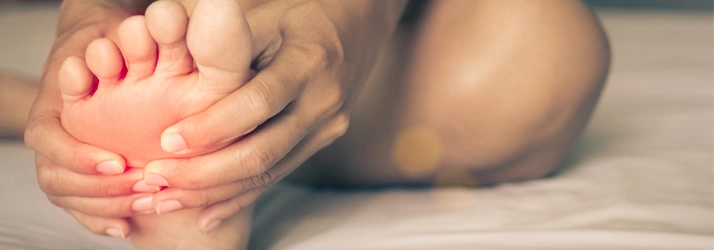Step into Relief: Laser Therapy for Morton's Neuroma in Stillwater MN

Morton's neuroma, is a painful condition affecting the nerves in the foot. This ailment often goes undiagnosed or misdiagnosed, causing distress and discomfort for those affected.
Traditional treatment options, while somewhat effective, may not always provide the desired relief. However, recent advancements in technology have paved the way for a promising alternative: laser therapy in Stillwater MN.
In this blog, we delve into the signs and symptoms of Morton's Neuroma, explore traditional treatment methods, and highlight how laser therapy has emerged as a superior option for alleviating the pain associated with this condition.
Understanding Morton's Neuroma in Stillwater MN
Morton's neuroma, is a nerve disorder that primarily affects the ball of the foot, typically between the third and fourth toes. It occurs when the tissue surrounding a nerve in the foot thickens, causing compression and irritation. This compression can result in a variety of symptoms, including:
- Sharp, shooting pain in the ball of the foot or between the toes.
- Burning or tingling sensation in the affected area.
- Numbness or loss of sensation in the toes.
- The feeling of having a pebble or object in the shoe.
- Increased pain when walking or wearing tight shoes.
Individuals who frequently engage in activities that involve repetitive pressure on the forefoot, such as running or wearing high heels, are more susceptible to developing Morton's neuroma. Additionally, people with certain foot deformities, such as bunions or hammertoes, may be at a higher risk.
Traditional Treatment Options and Their Limitations: Traditionally, treatment for Morton's neuroma has focused on managing symptoms rather than addressing the underlying cause. Common approaches include:
- Footwear modifications: Wearing shoes with a wider toe box or lower heels can help alleviate pressure on the affected area.
- Orthotic devices: Custom-made shoe inserts or pads can provide support and cushioning, reducing irritation to the nerve.
- Corticosteroid injections: Injections of corticosteroids into the affected area can temporarily reduce inflammation and alleviate pain.
While these treatments may offer some relief, they often come with limitations. Corticosteroid injections, for example, provide temporary pain relief but may not address the underlying nerve compression. Surgery, another treatment option, carries risks such as prolonged recovery time and potential complications.
Laser Therapy: A Promising Alternative
In recent years, laser therapy has emerged as a groundbreaking treatment option for Morton's neuroma. Low-level laser therapy (LLLT), also known as cold laser therapy, involves the use of specific wavelengths of light to stimulate cellular activity and promote healing. Several studies have demonstrated the effectiveness of laser therapy in relieving the pain associated with Morton's Neuroma.
One study published in the Journal of Foot and Ankle Research found that laser therapy significantly reduced pain and improved function in patients with Morton's neuroma. The researchers concluded that LLLT is a safe and effective treatment option, offering long-lasting pain relief without the need for surgery or medication.
Another study published in the Journal of the American Podiatric Medical Association compared the efficacy of laser therapy to corticosteroid injections for the treatment of Morton's neuroma. The results showed that laser therapy was equally effective in reducing pain and improving function, with the added benefit of fewer side effects.
How Laser Therapy Works
Laser therapy works by targeting the affected area with concentrated beams of light. These photons penetrate the skin and are absorbed by the mitochondria, the energy-producing organelles within cells. This stimulation promotes cellular repair and regeneration, helping to reduce inflammation and alleviate pain.
Unlike corticosteroid injections or surgery, laser therapy is non-invasive and painless. Treatment sessions are typically short, lasting around 10 to 15 minutes, and patients can resume their normal activities immediately afterward. Many individuals experience significant pain relief after just a few sessions, with continued improvement over time.
Conclusion
Morton's neuroma can significantly impact quality of life, causing persistent pain and discomfort. While traditional treatment options may offer temporary relief, they often fall short in addressing the underlying cause of the condition. Laser therapy, with its proven efficacy and minimal side effects, has emerged as a superior alternative for managing Morton's neuroma. By harnessing the power of light, laser therapy provides safe and effective pain relief, allowing individuals to step into a life free from foot pain.
Exclusive offer for those suffering from Morton's Neuroma that desperately need help and want to feel better fast. If you'd like to see if you qualify for Dr. Hanson's treatment program for Morton's Neuroma, take advanatge of this limited time offer.
Until the end of April (April 30th, 2024) you can schedule an absolutely free Morton's Neuroma Solution Evaluation in Dr. Hanson's Stillwater MN office. Simply click the button below and schedule an appointment with Dr. Hanson. (Write "Morton's Eval" in the notes and you're all set!)
Schedule Your Morton's Evaluation Here!
References
- Thomson CE, et al. (2012). Low-level laser therapy for the treatment of chronic plantar fasciitis: a prospective study. Journal of Foot and Ankle Research, 5:22.
- Hyland MR, et al. (2008). Efficacy of low-level laser therapy in the management of neck pain: a systematic review and meta-analysis of randomised placebo or active-treatment controlled trials. The Lancet, 5(12): 820-829.
- Kılcılar M, et al. (2018). Low-level laser therapy versus corticosteroid injection in the treatment of plantar fasciitis: A randomized controlled trial. Foot and Ankle Surgery, 24(3): 190-194.
OFFICE HOURS
Monday
9:30am - 5:00pm
Tuesday
9:30am - 12:30pm
Wednesday
9:30am - 5:00pm
Thursday
9:30am - 5:00pm
Friday
Closed
Saturday & Sunday
Closed
Bridgeview Chiropractic & Laser
13481 60th St N
Stillwater, MN 55082




